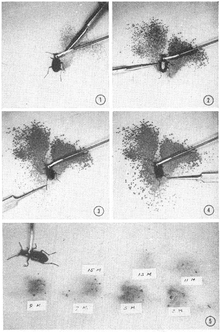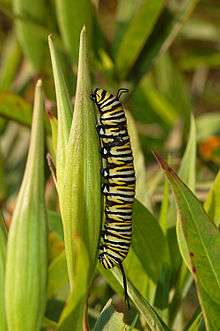Chemical ecology
Chemical ecology examines the role of chemical interactions between living organisms and their environment, and the consequences of those interactions on the ethology and evolution of the organisms involved. It is thus a vast and highly interdisciplinary field.[1][2] Chemical ecology studies focus on the biochemistry of ecology and the specific molecules or groups of molecules that function as signals to initiate, modulate, or terminate a variety of biological processes such as metabolism. Molecules that serve in such roles typically are readily diffusible organic substances of low molecular mass that derive from secondary metabolic pathways, but also include peptides. Chemical ecological processes mediated by semiochemicals may be intraspecific (occurring within a species) or interspecific (occurring between species).[3]
The field relies on analytical and synthetic chemistry, protein chemistry, genetics, neurobiology, ecology, and evolution.[4]
Chemical ecology of plants
Chemical ecology in plants is the study that integrates the chemistry and biological properties of the plants and their interaction with the environment (i.e. microorganisms, phytophagous insects) and their antagonists. Chemical ecology in plants mainly involves plants fighting herbivory by producing various phytochemical compounds. These compounds can be produced by the plants themselves, or as a part of various symbiotic relationships fungi and bacteria.[5]
The surface of the primary aerial parts of terrestrial plants is covered by a thin waxy structure known as the cuticle. The cuticle has crucial autecological functions and plays an important role as an interface in trophic interactions. The cuticle is composed of the cuticular layer and the cuticle proper, which is covered by epicuticular waxes. Whereas the cutin fraction is a polyester-type biopolymer composed of hydroxyl and hydroxy epoxy fatty acids, the cuticular waxes are a complex mixture of long-chain aliphatic and cyclic compounds. These highly lipophilic compounds determine the hydrophobic quality of the plant surface and together with the microstructure of the waxes, vary in a species-specific manner. The physiochemical characteristics contribute to certain optical features, limit transpiration and influence adhesion of particles and organisms, and as a result prevents it from undergoing wilting. Apart from that the cuticle acts like a skin for plants which prevents any mechanical damage to them from the external sources which either living organisms or any other abiotic component.[6]
In many cases, the chemical ecology of plants involves mutualistic interactions with other organisms. One of these involves interactions with fungi, and in particular, mycorrhizae- where fungi form a sheath on the outside of the roots, or penetrate the roots growing between root cells, and even pushing through cell walls of individual root cells. In this relationship, fungi produce chemicals that decompose organic matter in the soil around the root, absorb the inorganic nutrients released by this decomposition thanks to much larger surface area of the fungi threads, compared to the absorbing surface of the root, and pass some of the water and nutrient the plant, thus greatly enhancing the ability of the plant roots to extract nutrients and water from the soil. The fungi may also provide a chemical protection (antibiotics) against harmful bacteria and fungi in the soil.[7]
Interactions with microorganisms
Plants interact also with micro-organisms. For this to become possible the microbes have to establish an interface between them and the plant, by growing into the plant through its surface. To do so, the microbes need to break the protective hydrophobic waxy layer on the plant’s surface. To do this, the micro-organisms secrete special fluids which break down the fats from the cuticle.[6]
Growth in plants
Most of the hormones in plants are concentrated on their tips. The auxin hormones are responsible for growth of plants and are stimulated by certain stimulus such as light. This phenomenon is called phototropism, which is the movement towards or away from a light source. This growth enables the plant to obtain essentials such as sunlight which is very necessary for the photosynthesis. Therefore, the cuticle is one of the fundamental parts of the plant due to its physical and chemical properties such as waxy and thin like structure that enables it to be adapted to various mechanism such as hydrophobicity, interactions with microorganisms and growth of plants.[8]


Plant-insect interaction
The chemical ecology of plant-insect interaction is a significant subfield of chemical ecology.[2][9][5] In particular, plants and insects are often involved in a chemical evolutionary arms race. As plants develop chemical defences to herbivory, insects which feed on them evolve immunity to these poisons, and in some cases, re-purpose these poisons for their own chemical defence against predators. One of the more well-known examples of this is the monarch butterfly, the caterpillars of which feed on the milkweed plant. Milkweeds contain cardenolide toxins, but monarch butterfly caterpillars have evolved to remain unaffected by the toxin. Instead, they sequester the toxins during their larval stage and the poison remains in the adult, making it unpalatable to predators. Many other such examples of this exist, including Manduca sexta (tobacco hawk moth ) caterpillars which actively sequester nicotine found in the tobacco plant;[9] and the bella moth, which secretes a quinone-containing froth from its head when disturbed by a potential predator obtained from feeding on Crotalaria species as a caterpillar.
Marine chemical ecology
Marine chemical ecology is how organic life in the marine environment use chemicals to eat, interact, reproduce and survive, ranging from microscopic phytoplankton to the many species of crustaceans, sponges, coral and fish.
Defence
The use of chemicals are often used a means of survival for marine organisms. Some crustaceans and mesograzers, such as the Pseudamphithoides incurvaria, use particular algae and seaweeds as a means of deterrence by covering their bodies in the these plants. These plants produce alcohols such as pachydictyol-A and dictyol-E, which prevent the predation of the crustacean. When this seaweed is absent or another seaweed without these alcohols are worn, the rate at which these crustaceans are eaten is much higher. Other crustaceans use their natural defences in conjuncture with produced chemicals to defend themselves. Chemicals within their urine help coordinate them into groups. This combined with their spikes make them a much harder target for predators.[10] Others secrete mucus or toxins that make it difficult for predators to eat them, such as the Pardachirus marmoratus that use a toxin capable of paralyzing the jaws of a would-be predator. Simply being a certain colour can serve as a defence mechanism, such as some zoanthids displaying a wide range of colours. This suggests that they may be toxic to eat, whether they are or not.[11]
Reproduction
The release of chemicals are very important to coordinate marine organisms to reproduce. Some processes are relatively simple, such as attracting one individual to another. Male lampreys attract ovulating females by emitting a bile that can be detected many metres downstream. Other processes can be more complex, such as the mating habits of crabs. Due to the fact that mating can only be done shortly after the female moults from her shell, pheromones are produced and spread via urine before and after the moulting process. Male crabs will detect these and defend the potential mate until the shell has moulted. However due to the cabalistic tendencies of crabs, an additional pheromone is produced by the female to suppresses this urge. These pheromones are very potent, and have led to examples where male crabs have attempted to copulate with rocks or sponges exposed to these pheromones.[10]
Dominance
Determining dominance among crustaceans are very closely tied to chemical cues. When crustaceans fight to determine dominance they release urine, which helps to determine the victor. After a fight is concluded, both individuals will recognize each other in the future through urine, remembering who is the dominant of the two and thereby avoiding a fight. This can also have an impact on future fights. When an individual is exposed to the urine of a dominant crustacean, it will act more submissive, and oppositely when exposed to the urine of a subdominant individual. When individuals are unable to communicate through urine, fights can be longer and more unpredictable.[10]
See also
- Chemical defense
- Pheromone
- May R. Berenbaum
- Lincoln Brower
- Thomas Eisner
- Jerrold Meinwald
- Wendell L. Roelofs
References
- "What is Chemical Ecology? | Chemical Ecology". NCBS. Retrieved 2017-12-10.
- Dyer, Lee A.; Philbin, Casey S.; Ochsenrider, Kaitlin M.; Richards, Lora A.; Massad, Tara J.; Smilanich, Angela M.; Forister, Matthew L.; Parchman, Thomas L.; Galland, Lanie M. (2018-05-25). "Modern approaches to study plant–insect interactions in chemical ecology". Nature Reviews Chemistry. 2 (6): 50–64. doi:10.1038/s41570-018-0009-7. ISSN 2397-3358.
- Law, JH; Regnier, FE (1971). "Pheromones". Annual Review of Biochemistry. 40: 533–548. doi:10.1146/annurev.bi.40.070171.002533. PMID 4108191.
- Meinwald, J.; Eisner, T. (19 March 2008). "Chemical ecology in retrospect and prospect". Proceedings of the National Academy of Sciences. 105 (12): 4539–4540. doi:10.1073/pnas.0800649105. ISSN 0027-8424. PMC 2290750. PMID 18353981.
- Dyer, Lee A.; Philbin, Casey S.; Ochsenrider, Kaitlin M.; Richards, Lora A.; Massad, Tara J.; Smilanich, Angela M.; Forister, Matthew L.; Parchman, Thomas L.; Galland, Lanie M. (2018-05-25). "Modern approaches to study plant–insect interactions in chemical ecology". Nature Reviews Chemistry. 2 (6): 50–64. doi:10.1038/s41570-018-0009-7. ISSN 2397-3358.
- Müller, Caroline; Riederer, Markus (2005). "Plant Surface Properties in Chemical Ecology". Journal of Chemical Ecology. 31 (11): 2621–2651. doi:10.1007/s10886-005-7617-7. ISSN 0098-0331. PMID 16273432.
- Spiteller, Peter (2015). "Chemical ecology of fungi". Natural Product Reports. 32 (7): 971–993. doi:10.1039/C4NP00166D. PMID 26038303.
- Sondheimer, Ernest (2012-12-02). Chemical Ecology. Elsevier. ISBN 9780323154666.
- Mithfer, Axel; Boland, Wilhelm; Maffei, Massimo E. (2008), "Chemical Ecology of Plant–Insect Interactions", Molecular Aspects of Plant Disease Resistance, Wiley-Blackwell, pp. 261–291, doi:10.1002/9781444301441.ch9, ISBN 9781444301441
- Hay, Mark E. (2009). "Marine Chemical Ecology: Chemical Signals and Cues Structure Marine Populations, Communities, and Ecosystems". Annual Review of Marine Science. 1: 193–212. Bibcode:2009ARMS....1..193H. doi:10.1146/annurev.marine.010908.163708. ISSN 1941-1405. PMC 3380104. PMID 21141035.
- Bakus, Gerald J.; Targett, Nancy M.; Schulte, Bruce (1986). "Chemical ecology of marine organisms: An overview". Journal of Chemical Ecology. 12 (5): 951–987. doi:10.1007/bf01638991. ISSN 0098-0331. PMID 24307042.
Further reading
- Berenbaum MR & Robinson GE (2003). "Chemical Communication in a Post-Genomic World [Colloquium introductory article]". Proceedings of the National Academy of Sciences of the United States of America. 100 (Suppl 2, November 25): 14513. Bibcode:2003PNAS..10014513B. doi:10.1073/pnas.2335883100. PMC 304109. PMID 14595008.
- Wajnberg, Eric; Colazza, Stefano (2013). Chemical Ecology of Insect Parasitoids. Blackwell. ISBN 978-1118409527.
- Putnam, A. R. (1988). "Allelochemicals from Plants as Herbicides" Weed Technology. 2(4): 510-518.
External links
| Wikimedia Commons has media related to Chemical ecology. |
- A new antibiotic in African ants putatively protective of insect-fungi symbiosis through control of bacterial infections
- Insect Olfaction of Plant Odour
- International Society of Chemical Ecology
- "Search: Chemical ecology reviews". PubMed. U.S. National Library of Medicine.